Intel's Pentium M on the Desktop - A Viable Alternative?
by Anand Lal Shimpi on February 7, 2005 4:00 PM EST- Posted in
- CPUs
Business/General Use Performance
Business Winstone 2004
Business Winstone 2004 tests the following applications in various usage scenarios:- Microsoft Access 2002
- Microsoft Excel 2002
- Microsoft FrontPage 2002
- Microsoft Outlook 2002
- Microsoft PowerPoint 2002
- Microsoft Project 2002
- Microsoft Word 2002
- Norton AntiVirus Professional Edition 2003
- WinZip 8.1

In business applications, the Pentium M does extremely well - with the 755 offering performance equivalent to that of an Athlon 64 FX-55. This is undoubtedly due to the extremely low latency L2 cache, which matters considerably in business applications.
Office Productivity SYSMark 2004
SYSMark's Office Productivity suite consists of three tests, the first of which is the Communication test. The Communication test consists of the following:"The user receives an email in Outlook 2002 that contains a collection of documents in a zip file. The user reviews his email and updates his calendar while VirusScan 7.0 scans the system. The corporate web site is viewed in Internet Explorer 6.0. Finally, Internet Explorer is used to look at samples of the web pages and documents created during the scenario."
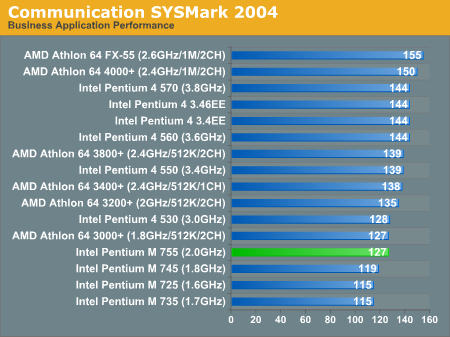
Immediately, we see that the Pentium M can't always do well, as even the 2.0GHz Pentium M 755 can't outperform the Athlon 64 3000+. The communication suite stresses memory bandwidth and latency rather than applications and usage patterns that fit into cache, so the Pentium M loses out big time.
The next test is Document Creation performance, which shows very little difference in drive performance between the contenders:
"The user edits the document using Word 2002. He transcribes an audio file into a document using Dragon NaturallySpeaking 6. Once the document has all the necessary pieces in place, the user changes it into a portable format for easy and secure distribution using Acrobat 5.0.5. The user creates a marketing presentation in PowerPoint 2002 and adds elements to a slide show template."
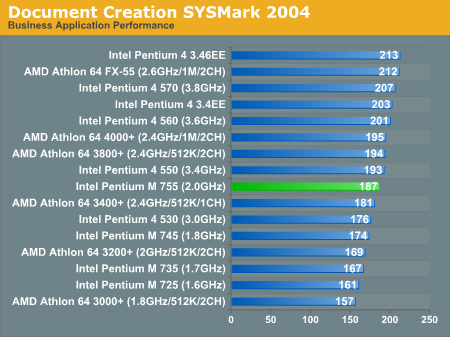
The Pentium M does a bit better in the document creation tests, as they are mostly using applications that will fit within the CPU's cache. However, the introduction of a voice recognition program into the test stresses the Pentium M's floating point performance, which does hamper its abilities here.
The final test in our Office Productivity suite is Data Analysis, which BAPCo describes as:
"The user opens a database using Access 2002 and runs some queries. A collection of documents are archived using WinZip 8.1. The queries' results are imported into a spreadsheet using Excel 2002 and are used to generate graphical charts."
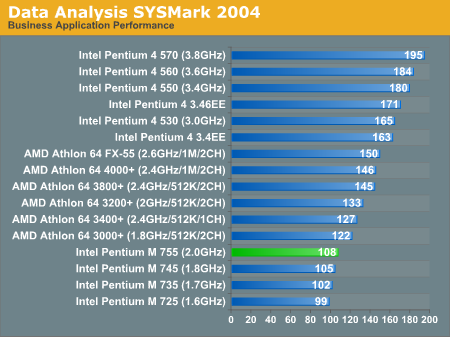
Without a doubt, the inclusion of Access usage patterns in the data analysis suite kills the Pentium M's chances here, as it once again brings up the tail in performance.
Microsoft Office XP SP-2
Here, we see in that the purest of office application tests, performance doesn't vary all too much.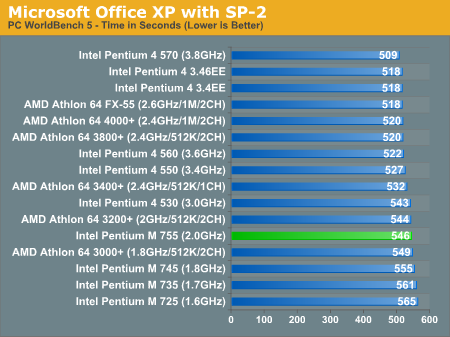
The Pentium M is competitive here, but so are all of the other CPUs.
Mozilla 1.4
Quite possibly the most frequently used application on any desktop is the one that we pay the least amount of attention when it comes to performance. While a bit older than the core that is now used in Firefox, performance in Mozilla is worth looking at as many users are switching from IE to a much more capable browser on the PC - Firefox.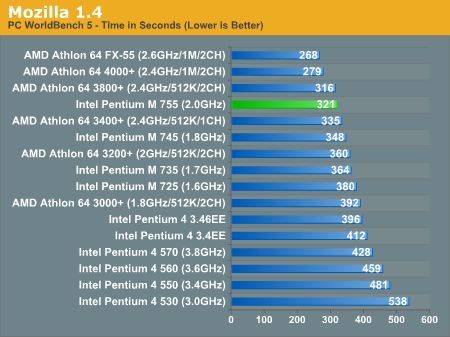
The Pentium M does extremely well here, outperforming both Athlon 64 and Pentium 4 competitors. Only the higher clock speed of the Athlon 64 gives it the overall lead here.
ACD Systems ACDSee PowerPack 5.0
ACDSee is a popular image editing tool that is great for basic image editing options such as batch resizing, rotating, cropping and other such features that are too elementary to justify purchasing something as powerful as Photoshop. There are no extremely complex filters here, just pure batch image processing.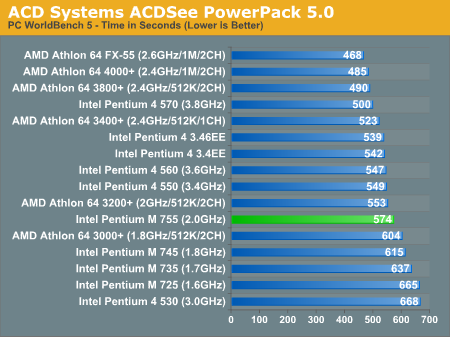
Once again, we see the Pentium M bring up the rear in situations where its low latency L2 cache can't help it.
Winzip
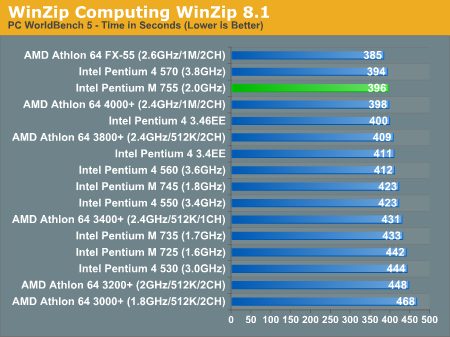
The Pentium M is fairly competitive in the real-world WinZip test - coming in third place overall, but the margin of victory isn't too great.
Let's look at how its peak theoretical performance is under WinRAR's built in benchmark:
WinRAR 3.40
Pulling the hard disk out of the equation, we can get a much better idea of which processors are truly best suited for file compression.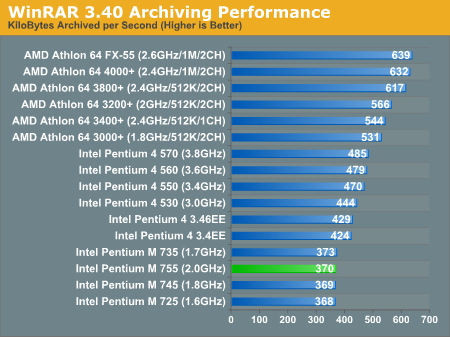
Here, we see that the lack of memory bandwidth really hurts the performance potential of the Pentium M. Luckily, most archiving tasks are usually disk-limited, so the performance differential won't be this bad in reality.










77 Comments
View All Comments
fitten - Tuesday, February 8, 2005 - link
Also, it's interesting that there are many benchmarks chosen which are known to stress the weaknesses of the Pentium-M... not that it isn't interesting information. For example, there seems to be a whole lot of FPU intensive benchmarks (around 15 or so, all of which the Pentium-M should lose handily - known before they are even run) so kind of just hammering the point home I guess.Anyway, the Dothans held up pretty well from what I can see... Most of the time (except for the notable FPU intensive and memory bandwidth intensive benchmarks), the Dothan compares quite well with Athlon64s of the same clock speed that have the advantage of dual channel memory.
fitten - Tuesday, February 8, 2005 - link
The other interesting thing about the Athlon64 vs. Dothan comparison is that even with dual channel memory bandwidth on the Athlon64's side, the single channel memory bandwidth of the Dothan still keeps it very close in many of the benchmarks and can even beat the dual channel Athlon64s at 400MHz higher clock in some.Anyway, the Pentium-M family is a good start. Some tweaking here and there (improved FPU with better FPU performance and maybe another FPU execution unit, improved memory subsystem to make good use of dual channel) and it will be at least as good as the Athlon64s across the board.
I own three Athlon64 desktops, two AthlonXP desktops, and two Pentium-M laptops and the laptops are by no means "slow" at doing work.
KristopherKubicki - Tuesday, February 8, 2005 - link
teutonicknight: We purposely don't change our test platform too often. Even though we are using a slightly older version of Premiere, it is the same version we have used in our other processor analyses.Hope that helps,
Kristopher
kmmatney - Tuesday, February 8, 2005 - link
There's also a Celeron version that would have been intersting to review. The small L2 cache should hurt the performance, though. I think the celeron version using something like 7 Watts. It would make no sense to put a celeron-M in such an expensive motherboard, though.Slaimus - Tuesday, February 8, 2005 - link
I think this indirectly shows how AMD needs to update its caching architecture on the K8. They basically carried over the K7 caches, which is just too slow when paired with its memory controller. Instead of being as large as possible (as evidenced by the exclusive caches) at the expense of latency, the K8 needs faster caches. The memory bandwith of L2 vs system memory is only about 2 to 1 on the K8, which is to say the L2 cache is not helping the system memory much.sandorski - Monday, February 7, 2005 - link
I think the Pentium M mythos can now be laid to rest.mjz5 - Monday, February 7, 2005 - link
to #29:your 2800 is the 754 pin.
the 3000+ reviewed is the 939 pin which is 1.8. the 3000+ for the 754 is 2.0 ghz
kristof007 - Monday, February 7, 2005 - link
I don't know if anyone else noticed but the charts are a bit off. My A64 2800+ is running at a stock 1.8 ghz .. while in the review the A64 3000+ is running at 1.8 ... weird!knitecrow - Monday, February 7, 2005 - link
#251) Intel and AMD measure TDP differently... and TDP is not the same as actual power dissipation. The actual dissipation of 90nm A64 is pretty darn good.
2) A microprocessor is not made of Lego... you can't rearrange/tweak parts to make it faster. It takes a lot of time, energy and talent to make changes -- even then it may not work for the best. Prescott anyone?
Frankly I’ve been waiting for a good review of P-M's actual performance. I really don't trust those "other" sites.
k00kie - Monday, February 7, 2005 - link